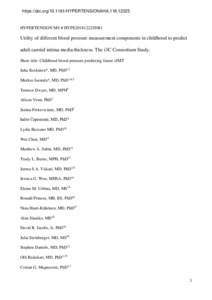Utility of Different Blood Pressure Measurement Components in Childhood to Predict Adult Carotid Intima-Media Thickness
David R. Jacobs; Jr; Olli Raitakari; Ronald Prineas; Alison Venn; Nina Hutri-Kähönen; Jorma S.A. Viikari; Jessica G. Woo; Lydia Bazzano; Wei Chen; Markus Juonala; Trudy L. Burns; Janina Petkeviciene; Costan G. Magnussen; Matthew A. Sabin; Julia Steinberger; Juha Koskinen; Alan Sinaiko; Stephen Daniels; Elaine M. Urbina; Indrė Čeponienė; Terence Dwyer
https://urn.fi/URN:NBN:fi-fe2021042824679
Tiivistelmä
Childhood blood pressure (BP) levels predict adult subclinical atherosclerosis. However, the best childhood BP component for prediction has not been determined. This study comprised 5925 participants aged 3 to 18 years from 6 cohorts who were followed into adulthood (mean follow-up 25.8±6.2 years). Childhood BP was measured by using a standard mercury sphygmomanometer in all cohorts. Study-specific carotid intima-media thickness ≥90th percentile was used to define subclinical atherosclerosis. Per SD change in the predictor, childhood systolic BP (SBP; age- and sex-adjusted odds ratio [95% CI], 1.24 [1.13–1.37]), mean arterial pressure (1.10 [1.07–1.13]), and pulse pressure (1.15 [1.05–1.27]) were associated with increased adulthood intima-media thickness. In age- and sex-adjusted analyses, area under the receiver operating characteristic curves for SBP (C value [95% CI], 0.677 [0.657–0.704]) showed significantly improved prediction compared with diastolic BP (0.669 [0.646–0.693], P=0.006) or mean arterial pressure (0.674 [0.653–0.699], P=0.01). Pulse pressure provided a C value that was not different from SBP (0.676 [0.653–0.699], P=0.16). Combining different BP components did not improve prediction over SBP measurement alone. Based on the associations with adult carotid intima-media thickness, cut points for elevated SBP were 105 mm Hg for 3- to 6-year-old boys, 108 mm Hg for 3- to 6-year-old girls, 108 mm Hg for 7- to 12-year-old boys, 106 mm Hg for 7- to 12-year-old girls, 123 mm Hg for 13- to 18-year-old boys, and 115 mm Hg for 13- to 18-year-old girls. Our analyses suggest that several childhood BP measurement components are related to adulthood carotid intima-media thickness. Of these, SBP provided the best predictive ability.
Kokoelmat
- Rinnakkaistallenteet [19250]
